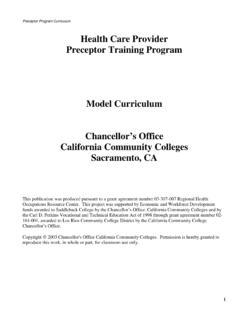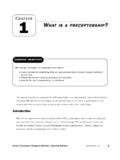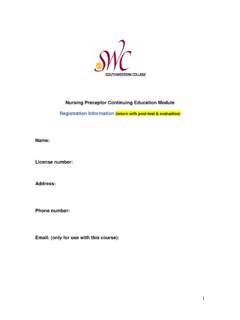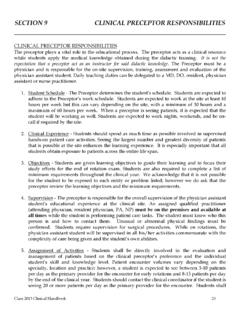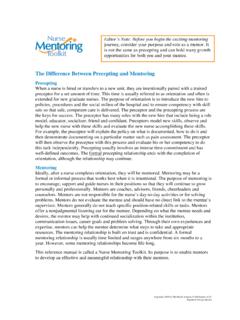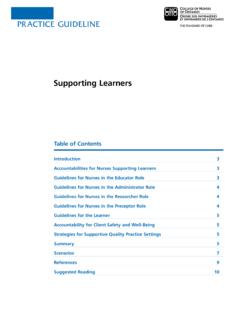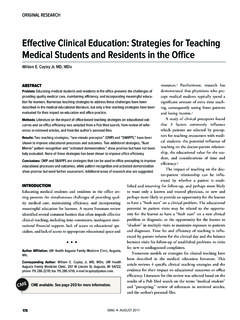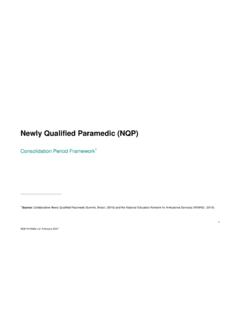Transcription of The Preceptor Role
1 No one was ever able to teach who was not 1. able to learn.. Florence Nightingale The Preceptor Role Beth Tamplet Ulrich, EdD, RN, FACHE, FAAN. Precepting is an organized, evidence-based, outcome-driven approach to assuring competent practice. Precepting is used for students who are rotating into clinical areas, for new graduate 1. Objectives nurse onboarding, for new hire onboarding, when experienced staff members learn a new specialty or new skills, and when individuals Understand precepting move into new roles ( , educator, manager, or Preceptor ). A in the context of nursing and the health care Preceptor is an individual with demonstrated competence in a system specific area who serves as a teacher/coach, leader/influencer, facilitator, evaluator, socialization agent, protector, and role model Understand the role of a to develop and validate the competencies of another individual.
2 Preceptor This chapter presents an overview of precepting and the Preceptor Know the competencies role. required to practice as a Preceptor Precepting takes place in the context of the health care system and involves many role functions. A precepting model that illustrates the roles and context of precepting is shown in Figure 2 Mastering Precepting: A Nurse's Handbook for Success Professional Competence and Relationships Preceptor roles Teacher/Coach Safety Leader/Influencer Quality Facilitator Evaluator Socialization Agent Protector Role Model Figure Precepting Model The Context of Precepting Precepting takes place in nursing and in the broader health care system. Professional nursing practice is complex and multifaceted. At its most basic, nursing is defined as the protection, promotion, and optimization of health and abilities, prevention of illness and injury, alleviation of suffering through the diagnosis and treatment of human response and advocacy in the care of individuals, families, communities, and populations (American Nurses Association [ANA], 2010a, p.)
3 3). Nursing has evolved into a profession that has a distinct body of knowledge, a social contract, and an ethical code. Nursing standards of practice describe a competent level of nursing care, and standards of professional performance describe a competent level of behavior in the professional role (ANA, 2010b; see Table ). In addition, the ANA Code of Ethics for Nurses provides a succinct statement of the ethical obligations and duties of every nurse. This code is the profession's nonnegotiable ethical standard and is an expression of nursing's own understanding of its commitment to society (ANA, 2001; see Table ). preceptors need to be grounded in these standards. 1 The Preceptor Role 3. Table Standards of Nursing Practice (ANA, 2010b, pp. 9-11). Standards of Practice Standard 1. Assessment. The registered nurse collects comprehensive data pertinent to the health care consumer's health and/or the situation.
4 Standard 2. Diagnosis. The registered nurse analyzes the assessment data to determine the diagnoses or issues. Standard 3. Outcomes Identification. The registered nurse identifies expected outcomes for a plan individualized to the health care consumer or the situation. Standard 4. Planning. The registered nurse develops a plan that prescribes strategies and alternatives to attain expected outcomes. Standard 5. Implementation. The registered nurse implements the identified plan. Standard 5A. Coordination of Care. The registered nurse coordinates care delivery. Standard 5B. Health Teaching and Health Promotion. The registered nurse employs strategies to promote health and a safe environment. Standard 5C. Consultation. The graduate level-prepared specialty nurse or advanced practice registered nurse provides consultation to influence the identified plan, enhance the abilities of others, and effect change.
5 Standard 5D. Prescriptive Authority and Treatment. The advanced practice registered nurse uses prescriptive authority, procedures, referrals, treatments, and therapies in accordance with state and federal laws and regulations. Standard 6. Evaluation. The registered nurse evaluates progress towards the attainment of outcomes. Standards of Professional Performance Standard 7. Ethics. The registered nurse practices ethically. Standard 8. Education. The registered nurse attains knowledge and competence that reflects current nursing practice. Standard 9. Evidence-based Practice and Research. The registered nurse integrates evidence and research findings into practice. Standard 10. Quality of Practice. The registered nurse contributes to quality nursing practice. Standard 11. Communication. The registered nurse communicates effectively in all areas of practice.
6 Standard 12. Leadership. The registered nurse demonstrates leadership in the professional practice setting and the profession. Standard 13. Collaboration. The registered nurse collaborates with the health care consumer, family, and others in the conduct of nursing practice. Standard 14. Professional Practice Evaluation. The registered nurse evaluates his or her own nursing practice in relation to professional practice standards and guidelines, relevant statutes, rules, and regulations. 4 Mastering Precepting: A Nurse's Handbook for Success Table Standards of Nursing Practice (ANA, 2010b, pp. 9-11) (cont.). Standard 15. Resource Utilization. The registered nurse utilizes appropriate resources to plan and provide nursing services that are safe, effective, and financially responsible. Standard 16. Environmental Health.
7 The registered nurse practices in an environmentally safe and healthy manner. Table ANA Code of Ethics (ANA, 2001). Provision 1. The nurse, in all professional relationships, practices with compassion and respect for the inherent dignity, worth, and uniqueness of every individual, unrestricted by considerations of social or economic status, personal attributes, or the nature of health problems. Provision 2. The nurse's primary commitment is to the patient, whether an individual, family, group, or community. Provision 3. The nurse promotes, advocates for, and strives to protect the health, safety, and rights of the patient. Provision 4. The nurse is responsible and accountable for individual nursing practice and determines the appropriate delegation of tasks consistent with the nurse's obligation to promote optimum patient care.
8 Provision 5. The nurse owes the same duties to self as to others, including the responsibility to preserve integrity and safety, to maintain competence, and to continue personal and professional growth. Provision 6. The nurse participates in establishing, maintaining, and improving health care environments and conditions of employment conducive to the provision of quality health care and consistent with the values of the profession through individual and collective action. Provision 7. The nurse participates in the advancement of the profession through contributions to practice, education, administration, and knowledge development. Provision 8. The nurse collaborates with other health professionals and the public in promoting community, national, and international efforts to meet health care needs. Provision 9. The profession of nursing, as represented by associations and their members, is responsible for articulating nursing values, for maintaining the integrity of the profession and its practice, and for shaping social policy.
9 Over the past decade, the Institute of Medicine (IOM) and other agencies and associations have conducted and published the results of a number of studies relevant to nursing practice in the context of the health care system. The two prevalent themes of these studies have been quality and safety. 1 The Preceptor Role 5. In its 2000 report To Err Is Human: Building a Safer Health System, the IOM discussed the issue of errors in hospitals, estimating that as many as 98,000 hospitalized Americans die each year not as a result of their illness or disease, but as a result of errors in their care. That report was followed closely in 2001 by an IOM report entitled Crossing the Quality Chasm: A New Health System for the 21st Century that identified health care quality issues, called for a radical redesign of the health care system, and proposed six quality outcomes: safety, effectiveness, patient-centeredness, timeliness, efficiency, and equity.
10 This report also emphasized that safety and quality issues are more often the result of systems issues than of individual performance. The Crossing the Quality Chasm report was followed in 2003 by Health Professions Education: A Bridge to Quality, which focused on integrating a core set of competencies into the education of all health professionals. The five core competencies for all clinicians are: 1. Provide patient-centered care. 2. Work in interdisciplinary teams. 3. Employ evidence-based practice. 4. Apply quality improvement. 5. Utilize informatics (IOM, 2003). The Agency for Healthcare Research and Quality (AHRQ) then asked the IOM to conduct a study to identify key aspects of the work environment for nurses that likely have an impact on patient safety and potential improvements in health care working conditions that would likely increase patient safety.
